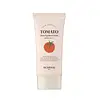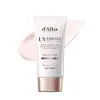What's inside
What's inside
 Key Ingredients
Key Ingredients

 Benefits
Benefits

 Concerns
Concerns

 Ingredients Side-by-side
Ingredients Side-by-side

Water
Skin ConditioningCyclopentasiloxane
EmollientEthylhexyl Methoxycinnamate
UV AbsorberCI 77891
Cosmetic ColorantDipropylene Glycol
HumectantZinc Oxide
Cosmetic ColorantEthylhexyl Salicylate
UV AbsorberCaprylyl Methicone
Skin ConditioningButylene Glycol
HumectantCetyl PEG/PPG-10/1 Dimethicone
EmulsifyingSorbitan Isostearate
EmulsifyingDisteardimonium Hectorite
StabilisingMagnesium Sulfate
Aluminum Hydroxide
EmollientStearic Acid
CleansingCaprylyl Glycol
EmollientParfum
MaskingHydroxyacetophenone
AntioxidantDimethicone
EmollientTriethoxycaprylylsilane
Solanum Lycopersicum Fruit Extract
Antioxidant1,2-Hexanediol
Skin ConditioningCitric Acid
BufferingGlycerin
HumectantLactic Acid
BufferingNelumbo Nucifera Flower Extract
Skin ConditioningPrunus Mume Fruit Extract
HumectantWater, Cyclopentasiloxane, Ethylhexyl Methoxycinnamate, CI 77891, Dipropylene Glycol, Zinc Oxide, Ethylhexyl Salicylate, Caprylyl Methicone, Butylene Glycol, Cetyl PEG/PPG-10/1 Dimethicone, Sorbitan Isostearate, Disteardimonium Hectorite, Magnesium Sulfate, Aluminum Hydroxide, Stearic Acid, Caprylyl Glycol, Parfum, Hydroxyacetophenone, Dimethicone, Triethoxycaprylylsilane, Solanum Lycopersicum Fruit Extract, 1,2-Hexanediol, Citric Acid, Glycerin, Lactic Acid, Nelumbo Nucifera Flower Extract, Prunus Mume Fruit Extract
Water
Skin ConditioningDibutyl Adipate
EmollientPropanediol
SolventTitanium Dioxide
Cosmetic ColorantCaprylic/Capric Triglyceride
MaskingC12-15 Alkyl Benzoate
AntimicrobialDiethylamino Hydroxybenzoyl Hexyl Benzoate
UV FilterCaprylyl Methicone
Skin ConditioningEthylhexyl Triazone
UV AbsorberNiacinamide
SmoothingGlycerin
HumectantDiethylhexyl Butamido Triazone
UV Absorber1,2-Hexanediol
Skin ConditioningPentylene Glycol
Skin ConditioningPortulaca Oleracea Extract
Skin ConditioningEpilobium Angustifolium Flower/Leaf/Stem Extract
Skin ConditioningRhododendron Ferrugineum Extract
MaskingCentella Asiatica Extract
CleansingPrunus Persica Flower Extract
MoisturisingPrunus Persica Fruit Extract
AbrasivePrunus Serrulata Flower Extract
Skin ConditioningAloe Barbadensis Leaf Extract
EmollientHouttuynia Cordata Extract
Skin ConditioningTuber Magnatum Extract
Skin ConditioningCitrus Aurantium Dulcis Oil
MaskingCitrus Nobilis Peel Oil
MaskingSodium Hyaluronate
HumectantLitsea Cubeba Fruit Oil
MaskingRosa Damascena Flower Water
MaskingBetula Platyphylla Japonica Juice
Skin ConditioningPanthenol
Skin ConditioningPolyhydroxystearic Acid
EmulsifyingDimethicone/Vinyl Dimethicone Crosspolymer
Skin ConditioningVp/Eicosene Copolymer
Dimethiconol
EmollientTrisiloxane
Skin ConditioningCoco-Caprylate/Caprate
EmollientStearic Acid
CleansingSodium Polyacryloyldimethyl Taurate
Emulsion StabilisingAmmonium Polyacryloyldimethyl Taurate
Emulsion StabilisingAlumina
AbrasiveHydroxypropyl Methylcellulose Stearoxy Ether
Dicaprylyl Carbonate
EmollientXanthan Gum
EmulsifyingEthylhexylglycerin
Skin ConditioningAdenosine
Skin ConditioningSodium Polyacrylate
AbsorbentTriethoxycaprylylsilane
T-Butyl Alcohol
PerfumingPvm/Ma Copolymer
Emulsion StabilisingPolyether-1
Hydrolyzed Hyaluronic Acid
HumectantAllantoin
Skin ConditioningButylene Glycol
HumectantTocopherol
AntioxidantDisodium Phosphate
BufferingCitric Acid
BufferingCaprylyl Glycol
EmollientCI 77492
Cosmetic ColorantCI 77491
Cosmetic ColorantLimonene
PerfumingCitral
PerfumingWater, Dibutyl Adipate, Propanediol, Titanium Dioxide, Caprylic/Capric Triglyceride, C12-15 Alkyl Benzoate, Diethylamino Hydroxybenzoyl Hexyl Benzoate, Caprylyl Methicone, Ethylhexyl Triazone, Niacinamide, Glycerin, Diethylhexyl Butamido Triazone, 1,2-Hexanediol, Pentylene Glycol, Portulaca Oleracea Extract, Epilobium Angustifolium Flower/Leaf/Stem Extract, Rhododendron Ferrugineum Extract, Centella Asiatica Extract, Prunus Persica Flower Extract, Prunus Persica Fruit Extract, Prunus Serrulata Flower Extract, Aloe Barbadensis Leaf Extract, Houttuynia Cordata Extract, Tuber Magnatum Extract, Citrus Aurantium Dulcis Oil, Citrus Nobilis Peel Oil, Sodium Hyaluronate, Litsea Cubeba Fruit Oil, Rosa Damascena Flower Water, Betula Platyphylla Japonica Juice, Panthenol, Polyhydroxystearic Acid, Dimethicone/Vinyl Dimethicone Crosspolymer, Vp/Eicosene Copolymer, Dimethiconol, Trisiloxane, Coco-Caprylate/Caprate, Stearic Acid, Sodium Polyacryloyldimethyl Taurate, Ammonium Polyacryloyldimethyl Taurate, Alumina, Hydroxypropyl Methylcellulose Stearoxy Ether, Dicaprylyl Carbonate, Xanthan Gum, Ethylhexylglycerin, Adenosine, Sodium Polyacrylate, Triethoxycaprylylsilane, T-Butyl Alcohol, Pvm/Ma Copolymer, Polyether-1, Hydrolyzed Hyaluronic Acid, Allantoin, Butylene Glycol, Tocopherol, Disodium Phosphate, Citric Acid, Caprylyl Glycol, CI 77492, CI 77491, Limonene, Citral
 Reviews
Reviews

Ingredients Explained
These ingredients are found in both products.
Ingredients higher up in an ingredient list are typically present in a larger amount.
1,2-Hexanediol is a synthetic liquid and another multi-functional powerhouse.
It is a:
- Humectant, drawing moisture into the skin
- Emollient, helping to soften skin
- Solvent, dispersing and stabilizing formulas
- Preservative booster, enhancing the antimicrobial activity of other preservatives
Butylene Glycol (or BG) is used within cosmetic products for a few different reasons:
Overall, Butylene Glycol is a safe and well-rounded ingredient that works well with other ingredients.
Though this ingredient works well with most skin types, some people with sensitive skin may experience a reaction such as allergic rashes, closed comedones, or itchiness.
Learn more about Butylene GlycolCaprylyl Glycol is a humectant and emollient, meaning it attracts and preserves moisture.
It is a common ingredient in many products, especially those designed to hydrate skin. The primary benefits are retaining moisture, skin softening, and promoting a healthy skin barrier.
Though Caprylyl Glycol is an alcohol derived from fatty acids, it is not the kind that can dry out skin.
This ingredient is also used as a preservative to extend the life of products. It has slight antimicrobial properties.
Learn more about Caprylyl GlycolCaprylyl Methicone is a type of silicone.
It helps soften and soothe the skin by creating a thin film on top. This film helps trap moisture, keeping your skin hydrated.
Citric Acid is an alpha hydroxy acid (AHA) naturally found in citrus fruits like oranges, lemons, and limes.
Like other AHAs, citric acid can exfoliate skin by breaking down the bonds that hold dead skin cells together. This helps reveal smoother and brighter skin underneath.
However, this exfoliating effect only happens at high concentrations (20%) which can be hard to find in cosmetic products.
Due to this, citric acid is usually included in small amounts as a pH adjuster. This helps keep products slightly more acidic and compatible with skin's natural pH.
In skincare formulas, citric acid can:
While it can provide some skin benefits, research shows lactic acid and glycolic acid are generally more effective and less irritating exfoliants.
Most citric acid used in skincare today is made by fermenting sugars (usually from molasses). This synthetic version is identical to the natural citrus form but easier to stabilize and use in formulations.
Read more about some other popular AHA's here:
Learn more about Citric AcidGlycerin is already naturally found in your skin. It helps moisturize and protect your skin.
A study from 2016 found glycerin to be more effective as a humectant than AHAs and hyaluronic acid.
As a humectant, it helps the skin stay hydrated by pulling moisture to your skin. The low molecular weight of glycerin allows it to pull moisture into the deeper layers of your skin.
Hydrated skin improves your skin barrier; Your skin barrier helps protect against irritants and bacteria.
Glycerin has also been found to have antimicrobial and antiviral properties. Due to these properties, glycerin is often used in wound and burn treatments.
In cosmetics, glycerin is usually derived from plants such as soybean or palm. However, it can also be sourced from animals, such as tallow or animal fat.
This ingredient is organic, colorless, odorless, and non-toxic.
Glycerin is the name for this ingredient in American English. British English uses Glycerol/Glycerine.
Learn more about GlycerinStearic Acid is a fatty acid. It is an emollient, emulsifier, and texture enhancer.
As an emollient, stearic acid helps soften skin. It aids the skin's protective barrier by preventing water loss. It also provides a gentle cleansing effect without stripping away natural oils.
Stearic acid may also be used to enhance the texture of products. It can add volume and stabilize ingredients such as water and oil. This can help water and oil ingredients from separating.
Sources of stearic acid include animal or vegetable fats/oils such as coconut or shea. It can be naturally found in butter, cocoa butter, shea butter, vegetable fats, and animal tallow.
This ingredient may not be Malassezia folliculitis, or fungal-acne safe.
Learn more about Stearic AcidTriethoxycaprylylsilane is a silicone used to bind and stabilize ingredients.
As an emulsifier, it helps prevent ingredients from separating. This can help elongate the shelf life of products.
Triethoxycaprylylsilane is often used to coat mineral sunscreens ingredients to help give a better feel. It also helps reduce oxidative stress in sunscreens.
Learn more about TriethoxycaprylylsilaneWater. It's the most common cosmetic ingredient of all. You'll usually see it at the top of ingredient lists, meaning that it makes up the largest part of the product.
So why is it so popular? Water most often acts as a solvent - this means that it helps dissolve other ingredients into the formulation.
You'll also recognize water as that liquid we all need to stay alive. If you see this, drink a glass of water. Stay hydrated!
Learn more about Water